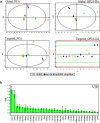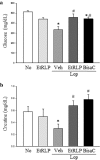Metabolomics approach to serum biomarker for laxative effects of red Liriope platyphylla in loperamide-induced constipation of SD rats
- PMID: 32257897
- PMCID: PMC7081617
- DOI: 10.1186/s42826-019-0009-x
Metabolomics approach to serum biomarker for laxative effects of red Liriope platyphylla in loperamide-induced constipation of SD rats
Abstract
Red Liriope platyphylla (RLP) is a known herbal medicine used in the treatment of some chronic diseases including constipation, neurodegenerative disorders, diabetes and obesity. To determine and characterize putative biomarkers that predict the laxative effects induced by RLP treatment, alteration of endogenous metabolites was measured in the serum of loperamide (Lop)-induced constipation rats after administration of RLP extract (EtRLP) using 1H nuclear magnetic resonance (1H NMR) spectral data. The urine volume and amounts, and weights and water contents of stools were significantly recovered in the Lop + EtRLP treated group as compared to the No group, whereas body weight and food intake maintained constant levels. Also, significant recoveries in the thickness of mucosa and muscle were detected in the colon of the Lop + EtRLP treated group. Furthermore, pattern recognition showed absolutely different clustering of the serum analysis parameters when comparing the Lop treated group and Lop + EtRLP treated group. Of the 33 endogenous metabolites, 7 amino acids (alanine, arginine, glutamate, glutamine, glycine, threonine and valine) and 8 endogenous metabolites (betaine, creatine, glucose, taurine, ethanol, lactate, glycerol and succinate) were dramatically increased in the Lop + EtRLP treated SD rats. These results provide the first evidence pertaining to metabolic changes in the constipation rats treated with Lop + EtRLP. Additionally, these findings correlate with changes observed in 15 metabolites during the laxative effects of EtRLP.
Keywords: Constipation; Laxative effects; Metabolomics; Red Liriope platyphylla; Serum.
© The Author(s) 2019.
Conflict of interest statement
Competing interestsThe authors declare that there is no financial conflict of interests to publish these results.
Figures





Similar articles
-
Spicatoside A in red Liriope platyphylla displays a laxative effect in a constipation rat model via regulating mAChRs and ER stress signaling.Int J Mol Med. 2019 Jan;43(1):185-198. doi: 10.3892/ijmm.2018.3960. Epub 2018 Oct 29. Int J Mol Med. 2019. PMID: 30387811 Free PMC article.
-
Aqueous extracts of Liriope platyphylla induced significant laxative effects on loperamide-induced constipation of SD rats.BMC Complement Altern Med. 2013 Nov 26;13:333. doi: 10.1186/1472-6882-13-333. BMC Complement Altern Med. 2013. PMID: 24274470 Free PMC article.
-
Metabolomics approach to serum biomarker for loperamide-induced constipation in SD rats.Lab Anim Res. 2014 Mar;30(1):35-43. doi: 10.5625/lar.2014.30.1.35. Epub 2014 Mar 24. Lab Anim Res. 2014. PMID: 24707303 Free PMC article.
-
Synergic Laxative Effects of an Herbal Mixture of Liriope platyphylla, Glycyrrhiza uralensis, and Cinnamomum cassia in Loperamide-Induced Constipation of Sprague Dawley Rats.J Med Food. 2019 Mar;22(3):294-304. doi: 10.1089/jmf.2018.4234. Epub 2019 Feb 6. J Med Food. 2019. PMID: 30724689
-
Laxative effects of Liriope platyphylla are tightly correlated with suppression of endoplasmic reticulum stress in loperamide-induced constipation of SD rats.Lab Anim Res. 2016 Mar;32(1):16-23. doi: 10.5625/lar.2016.32.1.16. Epub 2016 Mar 24. Lab Anim Res. 2016. PMID: 27051439 Free PMC article.
Cited by
-
Effects of natural products on functional constipation: analysis of active ingredient and mechanism.Naunyn Schmiedebergs Arch Pharmacol. 2024 Apr;397(4):2083-2103. doi: 10.1007/s00210-023-02786-x. Epub 2023 Oct 23. Naunyn Schmiedebergs Arch Pharmacol. 2024. PMID: 37870581 Review.
-
Effect of Electroacupuncture with Different Current Intensities on the Serum Metabolomics of Functional Constipation.Evid Based Complement Alternat Med. 2023 Jul 18;2023:9693390. doi: 10.1155/2023/9693390. eCollection 2023. Evid Based Complement Alternat Med. 2023. PMID: 37496821 Free PMC article.
-
Preclinical experimental models for assessing laxative activities of substances/products under investigation: a scoping review of the literature.Am J Transl Res. 2022 Feb 15;14(2):698-717. eCollection 2022. Am J Transl Res. 2022. PMID: 35273679 Free PMC article.
-
Gastrointestinal Characteristics of Constipation from the Perspectives of Microbiome and Metabolome.Dig Dis Sci. 2024 Apr;69(4):1318-1335. doi: 10.1007/s10620-024-08334-8. Epub 2024 Mar 6. Dig Dis Sci. 2024. PMID: 38446304
-
Ji-Chuan decoction ameliorates slow transit constipation via regulation of intestinal glial cell apoptosis.World J Gastroenterol. 2022 Sep 14;28(34):5007-5022. doi: 10.3748/wjg.v28.i34.5007. World J Gastroenterol. 2022. PMID: 36160643 Free PMC article.
References
-
- Lee Hak-Yong, Kim Jung-Hoon, Jeung Han-Wool, Lee Cha-Uk, Kim Do-Sung, Li Bo, Lee Geum-Hwa, Sung Myung-Soon, Ha Ki-Chan, Back Hyang-Im, Kim Sun-Young, Park Soo-Hyun, Oh Mi-Ra, Kim Min-Gul, Jeon Ji-Young, Im Yong-Jin, Hwang Min-Ho, So Byung-Ok, Shin Sook-Jeong, Yoo Wan-Hee, Kim Hyung-Ryong, Chae Han-Jung, Chae Soo-Wan. Effects of Ficus carica paste on loperamide-induced constipation in rats. Food and Chemical Toxicology. 2012;50(3-4):895–902. doi: 10.1016/j.fct.2011.12.001. - DOI - PubMed
LinkOut - more resources
Full Text Sources
Other Literature Sources

